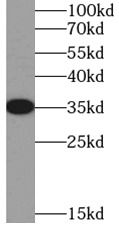Products
SIX2 antibody
| Size | Price |
|---|---|
| 100µg | Inquiry |
- SPECIFICATIONS
- FIGURES
- CONDITIONS
- FAQS
- Product Name
- SIX2 antibody
- Catalogue No.
- FNab07887
- Size
- 100μg
- Form
- liquid
- Purification
- Immunogen affinity purified
- Purity
- ≥95% as determined by SDS-PAGE
- Clonality
- polyclonal
- Isotype
- IgG
- Storage
- PBS with 0.02% sodium azide and 50% glycerol pH 7.3, -20℃ for 12 months(Avoid repeated freeze / thaw cycles.)
- Immunogen
- SIX homeobox 2
- Alternative Names
- Homeobox protein SIX2|Sine oculis homeobox homolog 2|SIX2 antibody
- UniProt ID
- Q9NPC8
- Observed MW
- 35 kDa
- Tested Applications
- ELISA, IF, IP, WB
- Recommended dilution
- WB: 1:500-1:1000; IP: 1:500-1:1000; IF: 1:20-1:200
 HEK-293 cells were subjected to SDS PAGE followed by western blot with FNab07887(SIX2 Antibody) at dilution of 1:600
HEK-293 cells were subjected to SDS PAGE followed by western blot with FNab07887(SIX2 Antibody) at dilution of 1:600
 IP Result of anti-SIX2 (IP:FNab07887, 3ug; Detection:FNab07887 1:500) with HEK-293 cells lysate 2700ug.
IP Result of anti-SIX2 (IP:FNab07887, 3ug; Detection:FNab07887 1:500) with HEK-293 cells lysate 2700ug.
 Immunofluorescent analysis of HEK293 cells using FNab07887(SIX2 Antibody) at dilution of 1:50 and Alexa Fluor 488-conjugated Goat Anti-Rabbit IgG(H+L)
Immunofluorescent analysis of HEK293 cells using FNab07887(SIX2 Antibody) at dilution of 1:50 and Alexa Fluor 488-conjugated Goat Anti-Rabbit IgG(H+L)
- Background
- Transcription factor that plays an important role in the development of several organs, including kidney, skull and stomach. During kidney development, maintains cap mesenchyme multipotent nephron progenitor cells in an undifferentiated state by opposing the inductive signals emanating from the ureteric bud and cooperates with WNT9B to promote renewing progenitor cells proliferation. Acts through its interaction with TCF7L2 and OSR1 in a canonical Wnt signaling independent manner preventing transcription of differentiation genes in cap mesenchyme such as WNT4. Also acts independently of OSR1 to activate expression of many cap mesenchyme genes, including itself, GDNF and OSR1. During craniofacial development plays a role in growth and elongation of the cranial base through regulation of chondrocyte differentiation. During stomach organogenesis, controls pyloric sphincter formation and mucosal growth through regulation of a gene network including NKX2-5, BMPR1B, BMP4, SOX9 and GREM1. During branchial arch development, acts to mediate HOXA2 control over the insulin-like growth factor pathway. Also may be involved in limb tendon and ligament development(By similarity). Plays a role in cell proliferation and migration.
How many times can antibodies be recycled?
First, usually it's not suggested to recycle antibodies. After use, buffer system of antibodies has changed. The storage condition of recycled antibodies for different customers also varies. Thus, the performance efficiency of recycled antibodies can’t be guaranteed. Besides, FineTest ever conducted the antibody recycling assay. Assay results show recycling times of different antibodies also varies. Usually, higher antibody titer allows more repeated use. Customers can determine based on experimental requirements.
Notes: After incubation, we recycle rest antibodies to centrifuge tube and store at 4℃. High titer antibodies can be stored for a minimum of one week. Reuse about three times.
What are components of FineTest antibody buffer?
Components of FineTest antibody buffer are usually PBS with proclin300 or sodium azide, BSA, 50% glycerol. Common preservative is proclin300 or sodium azide, which is widely applied in the lab and industry.
How about the storage temperature and duration of FineTest antibodies?
Most antibodies are stored at -20℃. Directly-labeled flow cytometry antibodies should be stored at 2 - 8℃. The shelf life is one year. If after sales issues for purchased antibodies appear, return or replacement is available. Usually, antibodies can be still used after the one-year warranty. We can offer technical support services.
Is dilution required for FineTest antibodies? What’s the dilute solution?
Directly-labeled flow cytometry antibodies are ready-to-use without dilution. Other antibodies are usually concentrated. Follow the dilution ratio suggested in the manual. Dilute solution for different experiments also varies. Common antibody dilution buffers are acceptable(e.g. PBST, TBST, antibody blocking buffer).
How to retrieve antibodies for immunohistochemistry?
Common retrieval buffers: Tris-EDTA Buffer(pH 9.0); Citrate Buffer(pH 6.0)
Heat induced antibody retrieval:
Method 1: Water-bath heating: Put the beaker with retrieval buffer and slide in the boiling water bath. Keep the boiling state for 15min. Naturally cool to room temperature;
Method 2: Microwave retrieval: Put the beaker with retrieval buffer and slide in the microwave oven. Heat at high power for 5min, Switch OFF for 3min, Heat at medium power for 5min. Naturally cool to room temperature.
How to choose secondary antibodies?
(1) Secondary antibodies react with primary antibodies. Thus, secondary antibodies should be against host species of primary antibodies. E.g. If the primary antibody is derived from rabbit, the relevant secondary antibody should be against rabbit. E.g. goat anti rabbit or donkey anti rabbit.
(2) Choose secondary antibody conjugates according to the experimental type, e.g. ELISA, WB, IHC etc. Common enzyme conjugated secondary antibodies are labelled by HRP, AP etc. Fluorescin or dye labelled secondary antibodies are applied in immunofluorescence and flow cytometry(e.g. FITC, Cy3).
